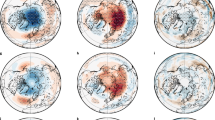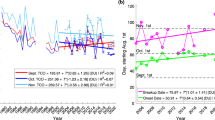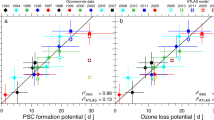Abstract
The chemical reactions responsible for stratospheric ozone depletion are extremely sensitive to temperature1. Greenhouse gases warm the Earth's surface but cool the stratosphere radiatively2,3,4,5 and therefore affect ozone depletion. Here we investigate the interplay between projected future emissions of greenhouse gases and levels of ozone-depleting halogen species using a global climate model that incorporates simplified ozone-depletion chemistry. Temperature and wind changes induced by the increasing greenhouse-gas concentrations alter planetary-wave propagation in our model, reducing the frequency of sudden stratospheric warmings in the Northern Hemisphere4. This results in a more stable Arctic polar vortex, with significantly colder temperatures in the lower stratosphere and concomitantly increased ozone depletion. Increased concentrations of greenhouse gases might therefore be at least partly responsible for the very large Arctic ozone losses observed in recent winters6,7,8,9. Arctic losses reach a maximum in the decade 2010 to 2019 in our model, roughly a decade after the maximum in stratospheric chlorine abundance. The mean losses are about the same as those over the Antarctic during the early 1990s, with geographically localized losses of up to two-thirds of the Arctic ozone column in the worst years. The severity and the duration of the Antarctic ozone hole are also predicted to increase because of greenhouse-gas-induced stratospheric cooling over the coming decades.
This is a preview of subscription content, access via your institution
Access options
Subscribe to this journal
Receive 51 print issues and online access
$199.00 per year
only $3.90 per issue
Buy this article
- Purchase on Springer Link
- Instant access to full article PDF
Prices may be subject to local taxes which are calculated during checkout




Similar content being viewed by others
References
Scientific Assessment of Ozone Depletion: 1994(Rep. 37, World Meteorological Organization, Geneva, (1995).
Fels, S. B., Mahlman, J. D., Schwarzkopf, M. D. & Sinclair, R. W. Stratospheric sensitivity to perturbations in ozone and carbon dioxide: radiative and dynamical response. J. Atmos. Sci. 37, 2265–2297 (1980).
Rind, D., Suozzo, R., Balachandran, N. K. & Prather, M. J. Climate change and the middle atmosphere. Part I: the doubled CO2climate. J. Atmos. Sci. 47, 475–494 (1990).
Rind, D., Shindell, D. T., Lonergan, P. & Balachandran, N. K. Climate change and the middle atmosphere. Part III: the doubled CO2climate revisited. J. Clim.(in the press).
Mahfouf, J. F., Cariolle, D., Royer, J.-F., Geleyn, J.-F. & Timbal, B. Response of the Météo-France climate model to changes in CO2and sea surface temperature. Clim. Dyn. 9, 345–362 (1994).
Manney, G. L., Santee, M. L., Froidevaux, L., Waters, J. W. & Zurek, R. W. Polar vortex conditions during the 1995–96 Arctic winter: Meteorology and MLS ozone. Geophys. Res. Lett. 23, 3203–3206 (1996).
Müller, R.et al. Severe chemical ozone loss during the Arctic winter of 1995–96. Nature 389, 709–712 (1997).
Rex, M.et al. Prolonged stratospheric ozone loss in the 1995–96 Arctic winter. Nature 389, 835–838 (1997).
Newman, P. A., Gleason, J. F., McPeters, R. D. & Stolarski, R. S. Anomalously low ozone over the Arctic. Geophys. Res. Lett. 24, 2689–2692 (1997).
Rind, D.et al. The GISS global climate/middle atmosphere model. Part I: model structure and climatology. J. Atmos. Sci. 45, 329–370 (1988).
Shindell, D. T., Wong, S. & Rind, D. Interannual variability of the Antarctic ozone hole in a GCM. Part 1: the influence of tropospheric wave variability. J. Atmos. Sci. 54, 2308–2319 (1997).
von Clarmann, T.et al. Determination of the stratospheric chlorine budget in the spring arctic vortex from MIPAS B limb emission spectra and air sampling experiments. J. Geophys. Res. 100, 13979–13997 (1995).
Woodbridge, E. L.et al. Estimates of total organic and inorganic chlorine in the lower stratosphere from in situ and flask measurements during AASE II. J. Geophys. Res. 100, 3057–3064 (1995).
Shindell, D. T., Rind, D. & Lonergan, P. Climate change and the middle atmosphere. Part IV: ozone response to doubled CO2. J. Clim.(in the press).
Shindell, D. T. & de Zafra, R. L. Limits on heterogeneous processing in the Antarctic spring vortex from a comparison of measured and modelled chlorine. J. Geophys. Res. 102, 1441–1449 (1997).
Jaeglé, L.et al. Evolution and stoichiometry of heterogeneous processing in the Antarctic stratosphere. J. Geophys. Res. 102, 13235–13253 (1997).
Shindell, D. T. & de Zafra, R. L. Chlorine monoxide in the Antarctic spring vortex 2. A comparison of measured and modelled diurnal cycling over McMurdo Station, 1993. J. Geophys. Res. 101, 1475–1487 (1996).
Santee, M. L., Manney, G. L., Read, W. G., Froidevaux, L. & Walters, J. W. Polar vortex conditions during the 1995–96 Arctic winter: MLS ClO and HNO3. Geophys. Res. Lett. 23, 3207–3210 (1996).
Pitari, G., Palermi, S., Visconti, G. & Prinn, R. G. Ozone response to a CO2doubling: results from a stratospheric circulation model with heterogeneous chemistry. J. Geophys. Res. 97, 5953–5962 (1992).
Cariolle, D., Lasserre-Bogorry, A., Royer, J. F. & Geleyn, J. F. Ageneral circulation model simulation of the springtime Antarctic ozone decrease and its impact on mid-latitutes. J. Geophys. Res. 95, 1883–1898 (1990).
Mahlman, J. D., Pinto, J. P. & Umscheid, L. J. Transport, radiative, and dynamical effects of the Antarctic ozone hole: A GFDL “SKYHI” model experiment. J. Atmos. Sci. 51, 489–508 (1994).
Austin, J., Butchart, N. & Shine, K. Possibility of an Arctic ozone hole in a doubled-CO2climate. Nature 360, 221–225 (1992).
Austin, J. & Butchart, N. The influence of climate change and the timing of stratospheric warmings on Arctic ozone depletion. J. Geophys. Res. 99, 1127–1145 (1994).
O'Neill, A. & Pope, V. D. Simulation of linear and non-linear disturbances in the stratosphere. Q. J. R. Meteorol. Sci. 114, 1063–1075 (1988).
Houghton, J. T., Callander, B. A. & Varney, S. K. (eds Climate Change 1992; The Supplementary Report to the IPCC Scientific Assessment(Cambridge Univ. Press, (1992).
Pawson, S. & Naujokat, B. Trends in daily wintertime temperatures in the northern stratosphere. Geophys. Res. Lett. 24, 575–578 (1997).
Kodera, K. & Koide, H. Spatial and seasonal characteristics of recent decadal trends in the northern hemispheric troposphere and stratosphere. J. Geophys. Res. 102, 19433–19447 (1997).
Zurek, R. W., Manney, G. L., Miller, A. J., Gelman, M. E. & Nagatani, R. M. Interannual variability of the north polar vortex in the lower stratosphere during the UARS mission. Geophys. Res. Lett. 23, 289–292 (1996).
Farman, J. C., Gardiner, B. G. & Shanklin, J. D. Large losses of total ozone in Antarctica reveal seasonal ClOx /NOx interaction. Nature 315, 207–210 (1985).
Montzka, S. A.et al. Decline in the tropospheric abundance of halogen from halocarbons: Implications for stratospheric ozone depletion. Science 272, 1318–1322 (1996).
Acknowledgements
We thank J. Hansen, R. de Zafra, G. Schmidt and J. Knox for comments. This work was supported by the NASA Atmospheric Chemistry Modeling and Analysis Program and the NASA Climate Modeling Program.
Author information
Authors and Affiliations
Corresponding author
Rights and permissions
About this article
Cite this article
Shindell, D., Rind, D. & Lonergan, P. Increased polar stratospheric ozone losses and delayed eventual recovery owing to increasing greenhouse-gas concentrations. Nature 392, 589–592 (1998). https://doi.org/10.1038/33385
Received:
Accepted:
Issue Date:
DOI: https://doi.org/10.1038/33385
This article is cited by
-
Dependence of column ozone on future ODSs and GHGs in the variability of 500-ensemble members
Scientific Reports (2023)
-
Climate change favours large seasonal loss of Arctic ozone
Nature Communications (2021)
-
Emergence of Southern Hemisphere stratospheric circulation changes in response to ozone recovery
Nature Geoscience (2021)
-
Polar Climate Change as Manifest in Atmospheric Circulation
Current Climate Change Reports (2018)
-
Three-dimensional analysis of ozone and PM2.5 distributions obtained by observations of tethered balloon and unmanned aerial vehicle in Shanghai, China
Stochastic Environmental Research and Risk Assessment (2018)
Comments
By submitting a comment you agree to abide by our Terms and Community Guidelines. If you find something abusive or that does not comply with our terms or guidelines please flag it as inappropriate.



